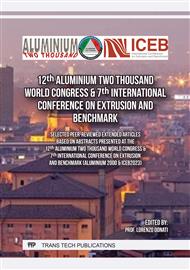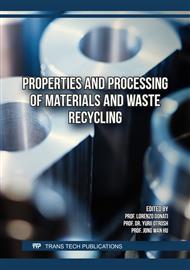[1]
L. Donati, B. Reggiani, R. Pelaccia, M. Negozio, S. Di Donato, Advancements in extrusion and drawing: a review of the contributes by the ESAFORM community, International Journal of Material 15 41 (2022).
DOI: 10.1007/s12289-022-01664-w
Google Scholar
[2]
L. Donati, A. Segatori, M. El Mehtedi, L. Tomesani, Grain evolution analysis and experimental validation in the extrusion of 6XXX alloys by use of a lagrangian FE code, International Journal of Plasticity 46 (2013) 70-81.
DOI: 10.1016/j.ijplas.2012.11.008
Google Scholar
[3]
R. Pelaccia, B. Reggiani, M. Negozio, L. Donati, Liquid nitrogen in the industrial practice of hot aluminium extrusion: experimental and numerical investigation, Int J Adv Manuf Technol 119 (2022) 3141-3155.
DOI: 10.1007/s00170-021-08422-3
Google Scholar
[4]
M. Negozio, R. Pelaccia, L. Donati, B. Reggiani, FEM Analysis of the Skin Contamination Behavior in the Extrusion of a AA6082 Profile, Key Engineering Materials Trans Tech Publications Ltd. (July 22, 2022).
DOI: 10.4028/p-y37nm3
Google Scholar
[5]
R. Pelaccia, B. Reggiani, M. Negozio, S. Di Donato, L. Donati, Investigation on the topological optimization of cooling channels for extrusion dies, Materials Research Proceedings 28 (2023) 533-542.
DOI: 10.21741/9781644902479-58
Google Scholar
[6]
I. Kniazkin, R. Pelaccia, M. Negozio, S. Di Donato, L. Donati, B. Reggiani, N. Biba, R. Rezvykh, I. Kulakov, Investigation of the skin contamination predictability by means of QForm UK extrusion code, Materials Research Proceedings 28 (2023) 543-552.
DOI: 10.21741/9781644902479-59
Google Scholar
[7]
M. Negozio, L. Donati, R. Pelaccia, B. Reggiani, S. Di Donato, Experimental analysis and modeling of the recrystallization behaviour of a AA6060 extruded profile, Materials Research Proceedings 28 (2023) 477-486.
DOI: 10.21741/9781644902479-52
Google Scholar
[8]
M. Negozio, R. Pelaccia, L. Donati, B. Reggiani, Simulation of the microstructure evolution during the extrusion of two industrial-scale AA6063 profiles, Journal of Manufacturing Processes 99 (2023) 501-512.
DOI: 10.1016/j.jmapro.2023.05.075
Google Scholar
[9]
F. Garofalo, An empirical relation defining the stress dependence of minimum creep rate in metals, Transactions of the Metallurgical Society of Aime 227 (April 1963) 351-356.
Google Scholar
[10]
C.M. Sellars, WJ McG Tegart, Memoires Scientifique Rev. Metallurg. 58 9 (1966) 731.
Google Scholar
[11]
G.E. Dieter, S.L. Semiatin, H.A. Kuhn, Handbook of Workability and Process Design, ASM International publications United States of America (2003) 86-127.
Google Scholar
[12]
L. Donati, M. El Mehtedi, Characterization of Flow Stress of Different AA6082 Alloys By Means Of Hot Torsion Test, AIPConf Proc 1353 (2011) 455-460.
DOI: 10.1063/1.3589557
Google Scholar
[13]
M. El Mehtedi, S. Spigarelli, F. Gabrielli, L. Donati, Comparison Study of Constitutive Models in Predicting the Hot Deformation Behavior of AA6060 and AA6063 Aluminium Alloys, Materials Today: Proceedings 2 10 Part A (2015) 4732-4739.
DOI: 10.1016/j.matpr.2015.10.006
Google Scholar
[14]
A. Hensel, T. Spittel, Kraft- und Arbeitsbedarf bildsamer Formgebungsverfahren, Deutscher Verlag für Grundstoffindustrie: Leipzig, Germany (1978) 336-360.
Google Scholar
[15]
G.R. Canova, U.F. Kocks, J.J. Jonas, Theory of torsion texture development, Acta metall. 32 2 (1984) 211-226.
DOI: 10.1016/0001-6160(84)90050-6
Google Scholar
[16]
A. Gräber, K. Pöhlandt, State of the art of the torsion test for determining flow curves, Steel Res. 61 (1990) 212-218.
DOI: 10.1002/srin.199000334
Google Scholar
[17]
D.S. Fields, W.A. Backofen, Determination of strain-hardening characteristics by torsion testing, 57 (1957) 1259-1272.
Google Scholar
[18]
B. Verlinden, A. Suhadi, L. Delaey, A generalized constitutive equation for an AA6060 Aluminium alloy, Scripta Metallurgica et Materialia 28 11 (1993) 1441-1446.
DOI: 10.1016/0956-716x(93)90496-f
Google Scholar
[19]
S. Spigarelli, E. Evangelista, H.J. McQueen, Study of hot workability of a heat treated AA6082 aluminum alloy, Scripta Materialia 49 (2003) 179-183.
DOI: 10.1016/s1359-6462(03)00206-9
Google Scholar
[20]
X. Chen,Y. Du, K. Du, T. Lian, B. Liu, Z. Li, X. Zhou, Identification of the Constitutive Model Parameters by Inverse Optimization Method and Characterization of Hot Deformation Behavior for Ultra-Supercritical Rotor Steel, Materials 14 8 (2021) 1958.
DOI: 10.3390/ma14081958
Google Scholar
[21]
H. Wang, W. Wang, R. Zhai, R. Ma, J. Zhao, Z. Mu, Constitutive Equations for Describing the Warm and Hot Deformation Behavior of 20Cr2Ni4A Alloy Steel, Metals. 10 9 (2020) 1169.
DOI: 10.3390/met10091169
Google Scholar



